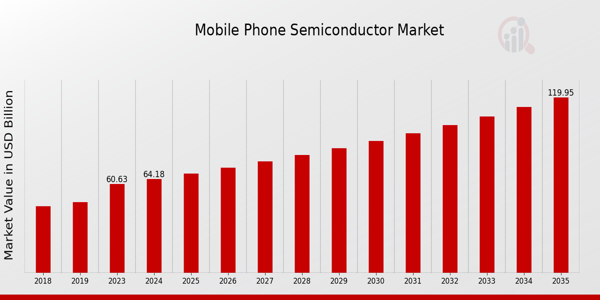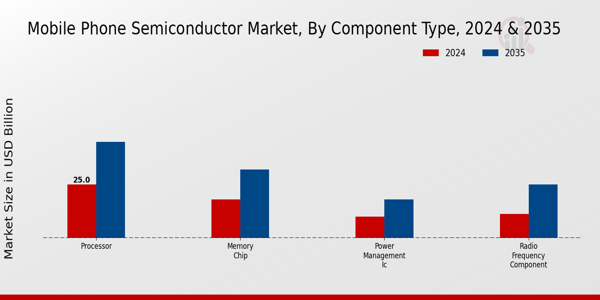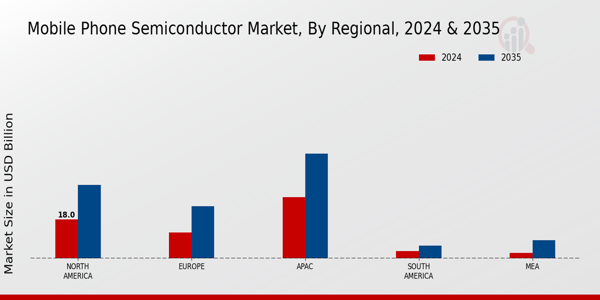Mobile Phone Semiconductor Market Overview:
Mobile Phone Semiconductor Market Size was estimated at 60.63 (USD Billion) in 2023. The Mobile Phone Semiconductor Industry is expected to grow from 64.18(USD Billion) in 2024 to 120.0 (USD Billion) by 2035. The Mobile Phone Semiconductor Market CAGR (growth rate) is expected to be around 5.85% during the forecast period (2025 - 2035).
Key Mobile Phone Semiconductor Market Trends Highlighted
The Mobile Phone Semiconductor Market is significantly influenced by key market drivers such as the rising adoption of smartphones and increasing demand for advanced features in mobile devices. With consumers seeking better performance, energy efficiency, and enhanced connectivity, semiconductor manufacturers are striving to innovate and deliver products that meet these expectations. The shift towards 5G technology also accelerates the demand for cutting-edge semiconductors that can support high-speed data transfer and improved network capabilities. Opportunities in this market are largely tied to the growing trend of Internet of Things (IoT) devices, which require semiconductor components for seamless functionality. As more devices become connected, there is a rising demand for specialized chips that enable communication and integration between mobile phones and other smart devices. Additionally, advancements in artificial intelligence and machine learning present an opportunity for semiconductor developers to create more powerful, efficient, and intelligent mobile devices.
In recent times, there has been a clear trend toward miniaturization of semiconductor components, driven by the need for slimmer smartphones and enhanced multi-functionality. Companies are also exploring heterogeneous integration, allowing different materials and technologies to be used together to improve performance. Sustainability has gained importance as well, prompting manufacturers to focus on eco-friendly production practices and materials. These evolving dynamics highlight the continuous innovation cycle within the market, tailoring products to meet consumer needs while embracing new technologies and sustainability efforts. Overall, the Mobile Phone Semiconductor Market is positioned for growth, fueled by both emerging technologies and changing consumer preferences.

Source: Primary Research, Secondary Research, MRFR Database and Analyst Review
Mobile Phone Semiconductor Market Drivers
Adoption of 5G Technology
The rapid adoption of 5G technology is a significant driver for the Mobile Phone Semiconductor Market Industry. As telecommunications companies and mobile manufacturers continue to roll out 5G networks, there is an increased demand for advanced semiconductors that can support the enhanced speed, bandwidth, and connectivity that 5G promises. This transition necessitates the development of more sophisticated chipsets that not only support 5G functionalities but also enhance other features such as battery life, processing speed, and overall device performance. With the projections indicating substantial growth in market valuation within the next decade, stakeholders in the semiconductor industry must innovate and adapt their offerings to keep pace with the requirements of 5G-enabled mobile devices. The expanding ecosystem of 5G applications, including augmented reality, virtual reality, and IoT (Internet of Things), further fuels demand, pushing manufacturers to invest in semiconductor technologies that can leverage these advanced capabilities. Thus, the demand for new manufacturing methods, more adept production processes, and advanced materials science is forcing changes within the semiconductor industry and, in turn, benefitting the entire mobile pharmaceutical sector. The 5G network will further enhance the way users interact with mobile devices. This development positions semiconductors at the core of this digital transformation to ensure the sustainability of their importance in the future of the mobile phone market.
Rising Demand for High-Performance Devices
As consumers increasingly seek high-performance smartphones with advanced capabilities, the Mobile Phone Semiconductor Market Industry is poised for growth. The demand for devices that can handle demanding applications, such as gaming, video streaming, and multitasking, drives manufacturers to integrate more powerful semiconductors. These high-performance chips enhance user experience and contribute to the overall value proposition of mobile devices, making them highly sought after in various consumer market segments.
Growth of Mobile Applications
The proliferation of mobile applications across various sectors is a primary driver propelling the Mobile Phone Semiconductor Market Industry. The expanding ecosystem of apps, including gaming, productivity, health, and social networking, fuels a stronger need for semiconductors that can manage diverse functionalities and performance levels. As developers continue to innovate, the demand for chips that can efficiently run these applications continues to rise, marking it as a significant catalyst for growth in the semiconductor market.
Mobile Phone Semiconductor Market Segment Insights:
Mobile Phone Semiconductor Market Component Type Insights
The Component Type segment of the Mobile Phone Semiconductor Market is a critical area, showcasing significant revenue through various essential components in mobile devices. As of 2024, the Processor segment commands a notable valuation of 25.0 USD Billion, growing substantially to reach 45.0 USD Billion by 2035, which illustrates its dominant role in driving mobile computing power and performance enhancement. Processors are fundamental to mobile phones, as they encompass the microprocessor units that manage the core functionality and user experience, thus holding the majority share within the overall market. Meanwhile, the Memory Chip segment also represents a significant portion, valued at 18.0 USD Billion in 2024 and expected to grow to 32.0 USD Billion by 2035. This emphasizes the importance of memory chips for data storage and performance, as they are essential for running applications and storing user data on mobile devices.
The Power Management IC segment has a valuation of 10.0 USD Billion in 2024, with expectations to rise to 18.0 USD Billion by 2035. These integrated circuits are increasingly becoming vital in managing energy consumption within mobile devices, a growing challenge as mobile manufacturers strive to enhance battery life and usage efficiency. Additionally, the Radio Frequency Component segment, valued at 11.18 USD Billion in 2024 and projected to escalate to 25.0 USD Billion by 2035, plays a significant role in enabling wireless communication technologies such as 5G, LTE, and Wi-Fi. The robust growth anticipated in this area underscores the escalating demand for better connectivity and the role of radio frequency components in driving the evolution of communication technologies.
Overall, the Mobile Phone Semiconductor Market revenue, driven by these core components, reflects an evolving landscape characterized by rapid advancements in mobile technology. Market growth is propelled by factors such as increasing smartphone penetration, evolving consumer preferences toward high-performance devices, and the proliferation of internet services. However, challenges like supply chain disruptions and the rising cost of raw materials pose threats to the market dynamics. The Mobile Phone Semiconductor Market segmentation highlights the diverse components that interconnect and sustain the mobile device ecosystem, with each category contributing uniquely to the broader industry landscape. Each component plays indispensable role, revealing considerable opportunities as technological advancements unfold and mobile phone capabilities continue to expand, fostering innovation and growth in the entire semiconductor market.

Source: Primary Research, Secondary Research, MRFR Database and Analyst Review
Mobile Phone Semiconductor Market Application Insights
This market encompasses several applications, including smartphones, feature phones, and wearable devices, which each play crucial roles in this segment. Smartphones dominate the landscape, driven by constant technological advancements, consumer demand for smart features, and increased internet penetration, making them integral for semiconductor consumption. Feature phones, while less prominent, continue to hold significant relevance in developing markets where basic communication needs remain paramount.Furthermore, wearable devices have gained momentum due to the rising interest in health and fitness tracking, enhancing their position within the market. The Mobile Phone Semiconductor Market revenue reflects the robust growth drivers in these applications while also highlighting potential challenges, such as competition in pricing and the need for innovation. Overall, the market segmentation presents a comprehensive view of evolving consumer preferences and technological trends, underscoring the importance of the application sector within the Mobile Phone Semiconductor Market statistics.
Mobile Phone Semiconductor Market Technology Insights
The Mobile Phone Semiconductor Market in the Technology segment has shown significant growth. The market is characterized by various components that play critical roles in the performance and advancement of mobile devices. Complementary Metal-Oxide-Semiconductor technology is a key player, known for its efficiency and cost-effectiveness, making it essential in modern mobile phone applications. Additionally, Radio Frequency Integrated Circuits are indispensable for seamless communication and connectivity, supporting the increasing demand for wireless features in smartphones. System on Chip solutions integrate multiple functions onto a single chip, significantly enhancing device performance while reducing power consumption. The Mobile Phone Semiconductor Market revenue reflects the importance of these technologies as they adapt to evolving consumer demands and technological advancements. Emerging trends and growth drivers include the shift towards 5G technology, which necessitates advanced semiconductor solutions to support high-speed data transmission and connectivity. However, challenges such as complex manufacturing processes and supply chain constraints remain prevalent, providing opportunities for innovation and growth within the market. The market's segmentation offers insights into a dynamic industry poised for continual expansion, illustrated by the expected valuation of 120.0 USD Billion by 2035.
Mobile Phone Semiconductor Market Manufacturing Process Insights
The Manufacturing Process segment of the Mobile Phone Semiconductor Market plays a crucial role in the overall landscape of the industry, contributing significantly to the efficiency and performance of mobile devices. This segment encompasses various processes, including Front-End, Back-End, and Packaging. The Front-End process is vital as it focuses on wafer fabrication and the initial stages of semiconductor manufacturing, ensuring quality and performance. The Back-End segment, which involves assembly, testing, and packaging, is equally important, as it determines the final product's reliability. Packaging, in particular, has become significant as it impacts both the functionality and form factor of mobile devices. Driven by trends in miniaturization and higher integration, the demand for advanced packaging techniques remains high. Overall, the Manufacturing Process segment is essential to the Mobile Phone Semiconductor Market, driven by technological advancements and evolving consumer preferences.
Mobile Phone Semiconductor Market Regional Insights
The Regional segment of the Mobile Phone Semiconductor Market demonstrates varied valuations and growth potential across different areas. In 2024, North America exhibits a substantial market value of 18.0 USD Billion, anticipated to grow to 33.6 USD Billion by 2035, reflecting its significant presence driven by technological advancements and a robust consumer base. Europe follows with a value of 12.0 USD Billion in 2024, increasing to 24.0 USD Billion in 2035, indicating a solid market driven by innovation in mobile technologies. The Asia-Pacific (APAC) region dominates this segment with a considerable valuation of 28.0 USD Billion in 2024 and projected to rise to 48.0 USD Billion by 2035, showcasing its majority holding due to high demand and production capabilities. South America and Middle East Africa (MEA) are relatively smaller markets, valued at 3.5 USD Billion and 2.68 USD Billion in 2024, expected to grow to 6.0 USD Billion and 8.4 USD Billion respectively by 2035. Despite being smaller, these regions hold opportunities for growth propelled by increasing mobile device penetration and demand for semiconductors. Thus, the Mobile Phone Semiconductor Market segmentation reveals varying dynamics, indicating where the highest growth and developments are expected based on existing valuations.

Source: Primary Research, Secondary Research, MRFR Database and Analyst Review
Mobile Phone Semiconductor Market Key Players and Competitive Insights:
The Mobile Phone Semiconductor Market has been experiencing significant growth owing to the increasing demand for smartphones and the continuous evolution of mobile technology. This competitive landscape is characterized by rapid technological advancements, shifting consumer preferences, and the growing integration of advanced features into mobile devices. As key players vying for market share, the focus remains on innovation, supply chain efficiency, and the ability to adapt to the dynamic needs of manufacturers and end-users alike. Competitive insights reveal that companies are channeling investments into research and development to stay ahead while also navigating challenges such as fluctuating raw material prices and geopolitical factors that could impact production capabilities. Infineon Technologies has established a notable presence in the Mobile Phone Semiconductor Market, driven by its robust portfolio of products designed for mobile applications. The company’s strengths lie in its expertise in power management and connectivity solutions, which are critical for enhancing the performance and energy efficiency of mobile devices. Infineon Technologies emphasizes its commitment to innovation, continually advancing technology to optimize the functionality of components used in smartphones. Furthermore, its strategic partnerships with leading manufacturers bolster its market position, allowing for a deeper integration of its semiconductor solutions across various applications. The company's ability to meet stringent quality standards also adds to its competitiveness, making it a trusted supplier in the mobile phone sector.
Intel’s involvement in the Mobile Phone Semiconductor Market reflects its broader strategy to diversify its portfolio beyond traditional computing platforms. The company is recognized for its high-performance processors which can cater to various mobile computing demands, including enhanced performance capacities and heat management. Intel's strengths include its established brand reputation and significant investment in research and development, which enables the company to drive innovation in mobile semiconductor technology. While traditionally more focused on personal computing, Intel is increasingly positioning itself as a viable player in the mobile space by adapting its technology to cater to the specific needs of mobile devices. Through collaborations and technological advancements, Intel aims to enhance its relevance in a rapidly evolving market, seeking to capture new opportunities as mobile device functionalities expand.
Key Companies in the Mobile Phone Semiconductor Market Include:
- Infineon Technologies
- Intel
- Broadcom
- MediaTek
- NXP Semiconductors
- Micron Technology
- Apple
- Skyworks Solutions
- Huawei
- Qualcomm
- Samsung Electronics
- Texas Instruments
- STMicroelectronics
- Analog Devices
- NVIDIA
Mobile Phone Semiconductor Industry Developments
Recent developments in the Mobile Phone Semiconductor Market have been marked by several significant trends and partnerships among key industry players. Companies like Qualcomm and MediaTek are continuing to innovate in 5G technologies, driving demand for advanced semiconductors. Apple recently showcased its latest A-series chips, which integrate AI capabilities, highlighting the increasing importance of artificial intelligence in consumer electronics. Samsung Electronics is ramping up production of memory chips, reflecting a growing demand for high-performance devices. On the mergers and acquisitions front, Infineon Technologies acquired a significant stake in a leading chip manufacturer to strengthen its position in the automotive semiconductor space, while Broadcom announced plans to expand its portfolio through strategic acquisitions aimed at enhancing connectivity solutions.
Meanwhile, NVIDIA continues to push the envelope in GPU technologies relevant to mobile applications. The market is projected to grow significantly as manufacturers like Micron Technology and STMicroelectronics expand their operations to meet rising global demand for smartphones and IoT devices. This growth is further fueled by increased investments in research and development, showcasing the commitment of these companies to innovate and capture market share amidst fierce competition.
Mobile Phone Semiconductor Market Segmentation Insights
Mobile Phone Semiconductor MarketComponent TypeOutlook
- Processor
- Memory Chip
- Power Management IC
- Radio Frequency Component
Mobile Phone Semiconductor MarketApplicationOutlook
- Smartphones
- Feature Phones
- Wearable Devices
Mobile Phone Semiconductor MarketTechnologyOutlook
- Complementary Metal-Oxide-Semiconductor
- Radio Frequency Integrated Circuit
- System on Chip
Mobile Phone Semiconductor MarketManufacturing ProcessOutlook
- Front-End
- Back-End
- Packaging
Mobile Phone Semiconductor MarketRegionalOutlook
- North America
- Europe
- South America
- Asia Pacific
- Middle East and Africa
|
Report Attribute/Metric
|
Details
|
|
Market Size 2023
|
60.63 (USD Billion)
|
|
Market Size 2024
|
64.18 (USD Billion)
|
|
Market Size 2035
|
120.0 (USD Billion)
|
|
Compound Annual Growth Rate (CAGR)
|
5.85% (2025 - 2035)
|
|
Report Coverage
|
Revenue Forecast, Competitive Landscape, Growth Factors, and Trends
|
|
Base Year
|
2024
|
|
Market Forecast Period
|
2025 - 2035
|
|
Historical Data
|
2019 - 2024
|
|
Market Forecast Units
|
USD Billion
|
|
Key Companies Profiled
|
Infineon Technologies, Intel, Broadcom, MediaTek, NXP Semiconductors, Micron Technology, Apple, Skyworks Solutions, Huawei, Qualcomm, Samsung Electronics, Texas Instruments, STMicroelectronics, Analog Devices, NVIDIA
|
|
Segments Covered
|
Component Type, Application, Technology, Manufacturing Process, Regional
|
|
Key Market Opportunities
|
5G technology integration, AI-driven chip development, Market shift to edge computing, Growing demand for IoT devices, Sustainability and recycling initiatives
|
|
Key Market Dynamics
|
Technological advancements,Increasing smartphone penetration, Competitive pricing strategies, Demand for 5G compatibility, Supply chain disruptions
|
|
Countries Covered
|
North America, Europe, APAC, South America, MEA
|
Frequently Asked Questions (FAQ) :
By 2024, the Global Mobile Phone Semiconductor Market is expected to be valued at 64.18 USD Billion.
The market is projected to reach approximately 120.0 USD Billion by 2035.
The market is expected to grow at a CAGR of 5.85% during the forecast period from 2025 to 2035.
The APAC region is expected to dominate the market with a value of 48.0 USD Billion by 2035.
The Processor segment of the market is valued at 25.0 USD Billion in 2024.
By 2035, the Memory Chip segment is projected to reach 32.0 USD Billion.
Major players include Infineon Technologies, Intel, Broadcom, MediaTek, NXP Semiconductors, Micron Technology, and Qualcomm.
The North American market is expected to be valued at approximately 33.6 USD Billion by 2035.
Key trends include advancements in mobile technology, increasing smartphone penetration, and demand for enhanced processing capabilities.
The market size for Power Management IC is valued at 10.0 USD Billion in 2024.













